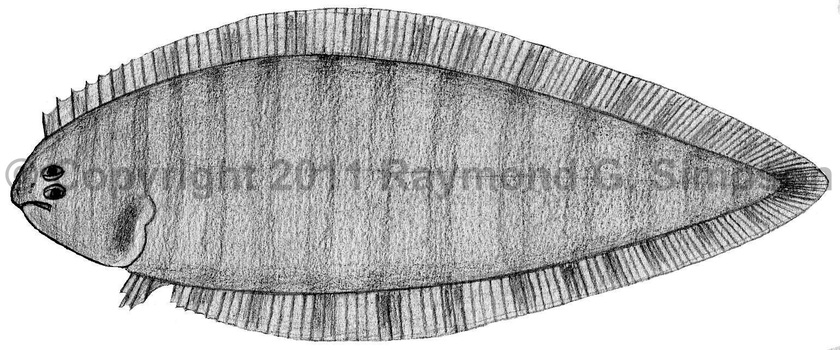
Common Name
Duskycheek Tonguefish
Year Described
Bloch and Schneider, 1801
Identification
Dorsal Fin Rays: 89-97
Anal Fin Rays: 73-81
Pectoral Fin Rays: none
Pelvic Fin Rays: 4
Caudal Fin Rays: 12
Longitudinal Scale Rows: 79-89
Vertebrae: 47-51
Pterygiophore pattern (1st three interneural spaces): 1-4-3
Other diagnostic characters include: pupillary operculum absent, fleshy ride present on ocular side lower jaw, andscales absent from blind side dorsal and anal fins
Color
Light brown to yellowish with 8-14 faint crossbands. Opercle usually body colored but can be dark due to the inner lining of the opercle showing through skin. Fins range from uniformly dusky to marked with alternating dark and light areas along length of fin. Caudal fin dark basally with dark streaks distally. Peritoneum unpigmented. Blind side cream without melanophores.
Size
Mature adults larger than 80mm. Maximum size is 130mm.
Habitat
A shallow water species found from 1-51m (usually <10m), over soft bottoms. Found in coastal waters and estuaries at all life stages.
Range Map

Range
Widespread in the Caribbean Sea, with records extending to SE South America. Has an allopatric distribution from S. plagiusa.
References
Munroe, T.A. 1998. Systematics and ecology of western Atlantic tonguefishes (Symphurus: Cynoglossidae: Pleuronectiformes). Fish. Bull. 96(1):1-182.
Munroe, T. A. 2003. Bothidae (Pp. 1885-1895), Scophthalmidae (Pp. 1896-1897), Paralichthyidae (Pp. 1898-1921), Poecilopsettidae (Pp. 1922-1923), Achiridae (Pp. 1925-1933), Cynoglossidae (Pp. 1934-1959). In: Carpenter. 2003. The living marine resources of the Western Central Atlantic v. 3.